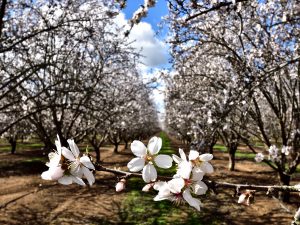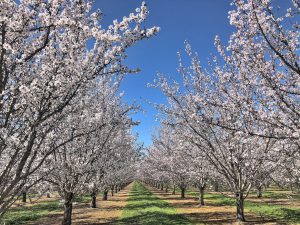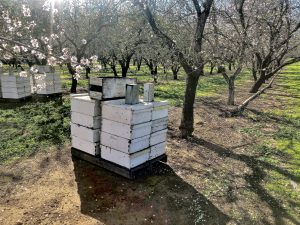This report covers the conditions and activities observed from February 19, 2021 to February 25, 2021. Written updates will be posted regularly on Fridays throughout bloom and will have a more regionalized focus. Additional updates will be posted as needed.
Bloom is peaking throughout California as orchards turn white as far as the eye can see. All regions have attained peak bloom in the soft shelled, early blooming varieties. The later blooming hard shelled varieties will reach the peak number of open flowers within the next few days. The central region continues to lead the way with Nonpareil and its California type pollinizers having reached peak bloom mid-week. The northern region is a day or two behind, while the south, which had been consistently five to six days behind since the start of bloom has caught up slightly with their counterparts in the central and northern regions.
Warmer temperatures in the region have spurred flower development and varieties are opening at a faster pace than at the beginning of bloom period. The warmer temperatures also helped with bee activity, providing good support for pollination. However, observers are reporting that winds ranging from 15 to 25 mph reduced bee activity in some areas of the central valley, reducing the number of hours of pollination. Growers also have concerns about drying winds reducing the viability of the open flowers.
“The weather so far has been great for the bloom. We have had many good, long days for the bees to work,” said Clinton Shick who farms in the McFarland area of Kern County. “They have been out at 52 degrees and have been able to work until about 5:00 pm on most days. Overall, the bloom appears to be lighter than last year.”
Observers have noted great variation in the stages of bloom between orchards. Also, as may be seen in the accompanying photos, there are orchards with significant variation in the number of flowers available for pollination. Orchards that produced excessively heavy crops in 2020 are presenting particularly poor “bud sets” this year. Greatest variation is typically noted in older orchards. However, some younger, more vibrant plantings are also presenting poor sets as well.
By Brian Noeller, Regional Manager
Photos by: Mel Machado, Matt Willson, Christine Ivory, Tim Sanchez, Ernie Reichmuth












